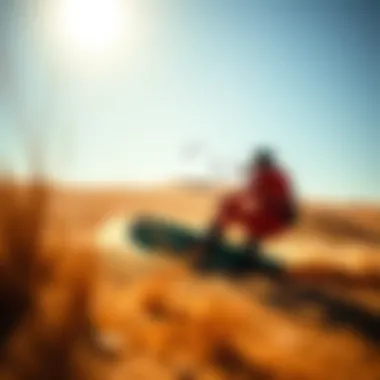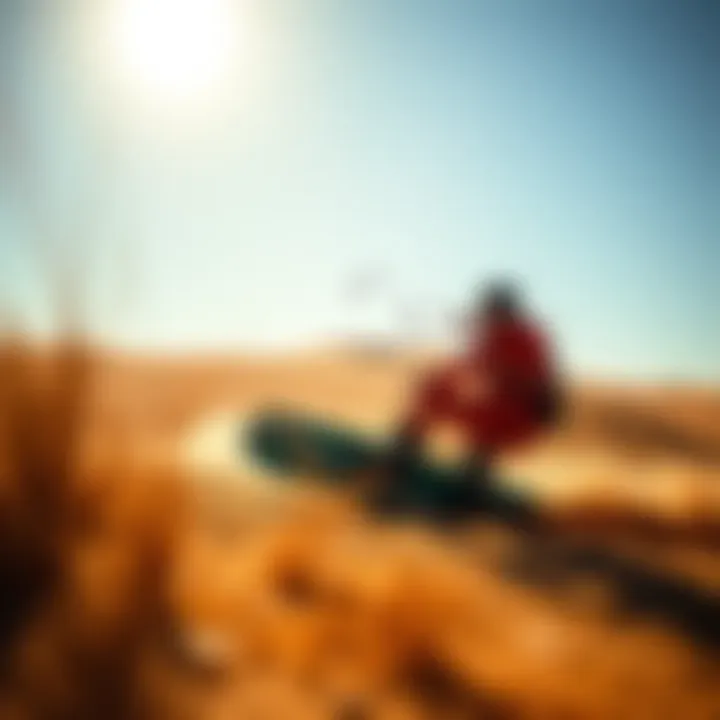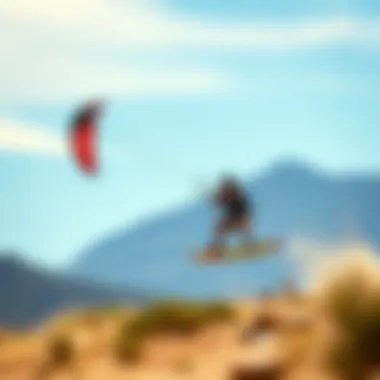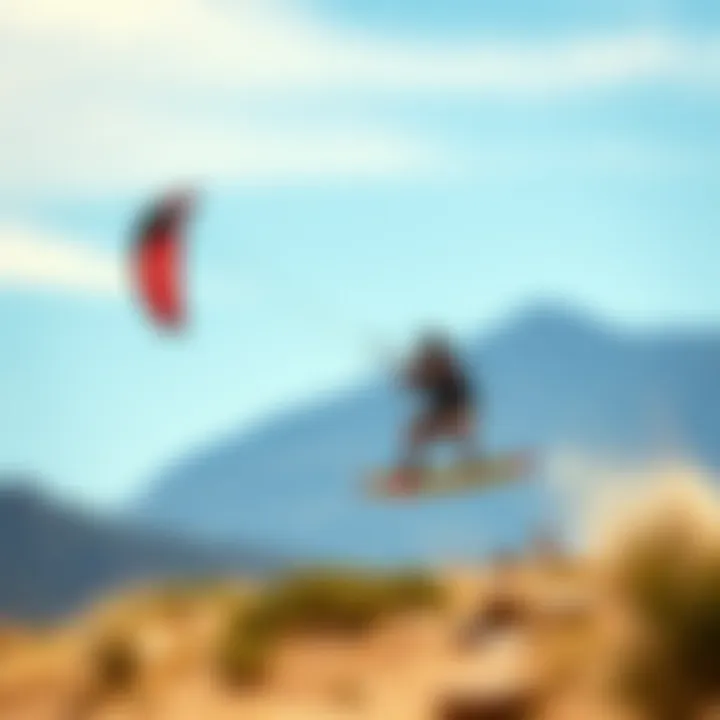Kiteboarding on Land: Techniques and Gear


Intro
Kiteboarding on land offers a unique twist to a thrilling sport that many are familiar with on water. It’s not just a matter of switching environments; it’s about adapting to different surfaces and wind dynamics. The exhilaration of power sliding across a smooth expanse of grass or hard-packed sand can be just as intense as carving through ocean waves. This article aims to delve into the specifics of land kiteboarding, from the selection of gear to mastering essential techniques, ensuring that both novices and seasoned riders can navigate this captivating discipline effectively.
Gear Selection
When it comes to land kiteboarding, the right equipment makes all the difference. Let’s look at what you’ll need to get started, particularly focusing on the types of kites and boards suited for this sport.
Types of Kites
Kites are the lifeblood of any kiteboarding experience, whether on land or sea. In land kiteboarding, specific types of kites are better suited due to the unique conditions and terrains involved. Here are a few notable types:
- Inflatable Kites: These are popular for their stability and easy relaunch capabilities. They handle wind better at lower speeds, making them ideal for beginners.
- Foil Kites: Known for their efficiency in light wind, foil kites offer a precise control and performance that can be advantageous in varying conditions.
- Power Kites: Typically used in traction sports, power kites are designed to generate significant pull, which can provide exhilarating speed and agility on land.
Selecting the right kite depends on your skill level and the terrain you’ll be riding on. Beginners may find inflatable kites more forgiving, while those with more experience might opt for the performance of foil kites.
Choosing the Right Board
The board acts as your feet on the ground, translating the kite’s pull into movement. In land kiteboarding, boards differ from traditional kiteboards found in water sports. It’s essential to pick one that meets your objectives:
- Directional Boards: These are designed for stability and speed, allowing the rider to dig into the ground during turns. They function well in grass and dirt, giving a smooth ride.
- Twin-Tip Boards: Symmetrical in shape, these boards let the rider ride in either direction, offering versatility, especially for freestyle maneuvers.
- Skateboards: A growing trend in land kiteboarding, skateboards allow for quick movements and a unique experience on flat surfaces.
When selecting a board, consider the type of terrain you plan to ride on, as well as your skills.
Skill Development
Just like with any sport, skill development in land kiteboarding is crucial to safely enjoy the ride and execute complex maneuvers. Let’s explore some essential techniques and tips for progression.
Essential Techniques
Mastering the basic skills sets the foundation for more advanced tricks. Here are some core techniques to focus on:
- Starting and Stopping: Learning to control your take-off and land smoothly is essential. This involves balancing the kite high and using foot pressure to glide efficiently.
- Turning and Carving: Engaging your body properly through turns allows for smoother transitions. Practice carving by shifting your weight while managing the kite’s position in the wind.
- Jumping: Once comfortable with basic movements, jumping provides a thrilling rush. Start by using a slight edge with your board and pulling down on the kite to achieve lift.
Progression Tips
Improvement comes with practice and patience. Here are some tips to elevate your abilities:
- Start Off Small: Begin with simple maneuvers, and gradually incorporate more challenging techniques into your routine. This builds confidence and minimizes the risk of accidents.
- Seek Feedback: Engaging with fellow kiteboarders can provide insights and constructive criticism. Whether through local clubs or online communities like reddit.com/r/kiteboarding, sharing experiences enriches your understanding.
- Watch the Wind: Always pay attention to wind patterns. Being in tune with your environment helps you grasp how it affects your riding, which is especially significant on land.
"Kiteboarding is as much about reading the wind and terrain as it is about being on the board."
For more information on kiteboarding gear and techniques, check out resources like kiteboarding.com and kiteforum.com.
Prelude to Land Kiteboarding
Kiteboarding on land is more than just a thrilling activity; it’s an exhilarating way to engage with the elements, merging skill, balance, and a bit of adventure. This section introduces the nuances of land kiteboarding and its significance in the broader landscape of extreme sports. While water kiteboarding is often recognized as the front-runner for kite enthusiasts, land kiteboarding offers an alternative that can be equally exciting, if not more so in certain conditions.
Definition and Overview
At its core, land kiteboarding involves harnessing the power of the wind using a specially designed kite while riding on a variety of surfaces. This can include hard-packed dirt, grassy fields, or even more rugged terrain like sand dunes. The fundamental technique revolves around maneuvering a kite while standing or sitting on either a board or a vehicle, such as a mountain board or buggy. It’s essential to understand that land kiteboarding presents its own set of challenges and demands a different skill set compared to its waterborne counterpart. The weight distribution on land is different, and how a rider reacts to terrain variances teaches a unique approach to using kite power.
Differences Between Land and Water Kiteboarding
A few key distinctions set land kiteboarding apart from its aquatic sibling:
- Surface Interaction: On land, riders deal with solid ground, which impacts the way they travel and how they anticipate their motion. Water reduces friction, allowing for smoother gliding, while land surfaces can be less forgiving, requiring greater control.
- Kite Control: Wind patterns behave differently over land compared to water. On land, factors like obstructions (trees, buildings) can create turbulent wind flows. Riders learn to read and adapt to these conditions, which can shift rapidly.
- Equipment Considerations: The gear varies significantly between the two modalities. For instance, while water kiteboarding typically requires a twin-tip board for riding the waves, land kiteboarding often utilizes larger wheels or specific tire designs suited for dust, grass, or sand.
Evolving Popularity of Land Kiteboarding
Why has land kiteboarding become such a captivating pursuit? The answer lies in the flexibility and accessibility it provides. Land kiteboarding can be practiced in various settings, from vast open fields to rugged terrains, making it easier for enthusiasts to find suitable spots, especially for those living far away from coastlines.
The community surrounding land kiteboarding has seen notable expansion in recent years, driven partly by social media showcasing remarkable feats and experiences. As enthusiasts share tips, tricks, and their personal journeys online, they inspire newcomers to try it out. Events across the globe attract not only seasoned riders but also curious spectators. This accessibility is key; people recognize that with a kite, a board, and a bit of wind, they can unleash some serious fun right where they live.


"Land kiteboarding opens new doors for those who seek adventure without the need for a beach. It’s all about harnessing the wind wherever you may be!"
These factors ultimately elevate the sport's visibility and bring fresh faces into the fold, contributing to a vibrant and growing land kiteboarding community.
Essential Gear for Land Kiteboarding
Engaging in land kiteboarding is not just about the thrill; it's also about the right equipment. Selecting proper gear ensures safety, performance, and a more enjoyable experience. Whether you're looking to cruise through an open field or navigate sandy terrain, the choice of gear tailored to land kiteboarding is critical.
Kites: Types and Specifications
When it comes to kites, understanding your options can make a world of difference. The common types include inflatable kites and foil kites. Inflatable kites are often favored for their durability and ease of use, especially for beginners. Their design includes air chambers that provide structure, making them stable in varying wind conditions.
Foil kites, on the other hand, are lightweight and packable—ideal for those who might want to travel or hike to their kiteboarding location. These kites rely on the wind to inflate during use, providing an agile experience.
In terms of size, kites typically range from 1.5 to 12 square meters. Smaller kites offer better control and speed for advanced maneuvers, while larger kites can capture more wind, providing power for off-the-ground jumps and tricks. Consider factors like wind speed and your weight when choosing a kite size. As a rule of thumb:
- 1.5-3 square meters for light winds
- 3-6 square meters for moderate winds
- 6 square meters and above for strong winds
Boards: Selecting the Right Option
The right board can significantly impact your riding experience. Generally, landboards come in two types: those designed for rougher surfaces with larger wheels, and lighter boards that are easier to maneuver on smooth terrain. Just as important is the length and width of the board. A longer board can offer greater stability, while a shorter one provides agility for tricks.
When you're out there ripping it across fields or dunes, a quality grip is vital. Many boards feature rubber grip tape to keep your feet in position, allowing for controlled movement.
Here’s what to keep in mind:
- Wheel size matters: Larger wheels can handle rugged terrain better.
- Material counts too: Look for sturdy designs that can endure bumps and jumps.
Harnesses: Importance of Fit and Functionality
Harnesses are perhaps the unsung heroes of land kiteboarding. Choosing a harness that fits well can impact comfort and control greatly. There are two main types: waist harnesses and seat harnesses. Waist harnesses provide a free range of motion, which is great for tricks but can lead to slipping if not fitted properly. Seat harnesses, conversely, secure tightly around your hips and are less likely to shift, making them a solid choice for beginners and those favoring stability.
The key here is to ensure you get the size right. A good harness should feel snug but not restrictive. Check for things like padding and adjustability—these features can make a difference on long riding days.
Safety Gear: Protecting Yourself from Impact
Safety should never take a back seat when kiteboarding, especially on land where obstacles abound. Essential safety gear includes helmets, knee pads, and elbow pads. Helmets protect against potential falls and collisions, while knee and elbow pads offer mobility without compromising safety.
Always keep in mind:
- Additional padding may be beneficial for beginners as they learn the ropes.
- Invest in quality gear that can last through your adventures.
“It’s better to gear up and ride safely than to risk injury and miss out on the thrill.”
Techniques for Successful Land Kiteboarding
Mastering the art of land kiteboarding requires a blend of skill, awareness, and adaptation to constantly changing environments. This section dives into the various techniques pivotal for ensuring both safety and enjoyment while navigating the unique challenges that land provides. From launching kites in tricky wind patterns to controlling speed and executing intricate maneuvers, understanding these techniques enhances the overall experience and sharpens one's skills on land. A well-rounded grasp of techniques not only boosts confidence but also sets the stage for thrilling adventures in diverse terrains.
Launching and Landing Techniques
Successfully launching and landing a kite is fundamental for any kiteboarding session, especially on land. In comparison to water, where sometimes you have a bit of give under your feet, land can be unforgiving. Ensuring the kite flies smoothly without snagging or causing you to faceplant is crucial. Here are some steps to follow:
- Choose the Right Spot: Look for a clear area free from obstacles such as trees, power lines, or other riders. You’ll want calm winds of about 10-20 knots for beginners.
- Prepare Your Equipment: Lay out your kite properly, ensuring the lines are untwisted and the kite is facing the correct direction.
- The Launch: Have a buddy hold the kite while you walk it back to the desired angle. Make sure to communicate before executing the launch. Once you’re ready, give a commanding signal, and your partner should let it rise smoothly into the air. Always keep an eye on the kite's position and make minor adjustments until it finds stable flight.
Landing involves a similar delicacy. Once you’re low on the wind window, signal your partner to be ready. Gently pull on one of the rear lines to move the kite down while maintaining control until it settles on the ground. Nothing like a clean landing to wrap up a session!
Navigating Different Terrain
Land kiteboarding opens up a garden of varied terrains, each posing its own set of challenges and requiring different approaches. Riding on grass, dirt, or sandy surfaces affects how you maneuver and balance your speed. Here’s how to navigate these different conditions:
- Grass: This terrain is forgiving, allowing for smoother rides. But remember, wet grass can lead to unexpected slips. Adjust your technique by lowering your kite slightly to gain traction and maintaining a stable stance.
- Dirt Trails: Here the terrain might be uneven. Watch for rocks and ruts. Leaning back helps absorb shocks; it keeps balance and control while navigating bumps in the trail. Staying alert is key.
- Sand Dunes: The shifting surfaces may hinder speed control. Shifting your weight forward into your toes can increase stability, and setting your kite at a low angle helps catch the wind effectively.
Regardless of the surface, it pays to read the land and adjust your kite's position to stay in sync with the ground.
Mastering Speed and Controlled Stops
One of the most exhilarating aspects of land kiteboarding involves speeding up and then, quite literally, stopping on a dime. It's essential to master acceleration and deceleration effectively to provide for safe rides:


- Acceleration: To boost speed, steer the kite towards the edge of the wind window without losing control. When you feel the kite pull, focus on leaning in, allowing your body to act as an anchor against the wind. Keep your knees slightly bent to maintain balance.
- Controlled Stops: When you want to halt, understanding your kite's position will greatly aid in stopping safely. Pull back on the rear lines to brake efficiently. As you slow, shift your weight back while hinting at a light pressure on the foot pads to avoid going over the front.
Executing Tricks and Maneuvers
Once you're comfortable with the basics—launching, landing, navigating, and controlling speed—it’s time to spice things up with tricks and maneuvers that highlight your capabilities on land. Here’s how to get started:
- Basic Tricks: Don’t rush to the big air tricks just yet. Start with simple moves like jumping small bumps or making basic spins. These are good for getting a feel of how your kite reacts under different conditions.
- Progress to Advanced: When you feel ready, try more complex tricks like the kite loop or the back roll. Each trick requires practice—don’t hesitate to crash. It’s all part of the learning curve. Keep in mind that technique separates a good rider from a great one.
- Capturing Style: Adding personal flair to your maneuvers sets you apart. Whether it’s a spin that’s unique to you or a stylish landing, displaying your personality enhances the aesthetic of your kiteboarding.
Remember: Consistent practice combined with mindfulness of your surroundings makes for a safer environment and paves the way for skill mastery in land kiteboarding.
Safety Protocols for Land Kiteboarding
Safety protocols are not just a doddle in the park; they are the backbone of any adventurous sport. When kiteboarding on land, understanding these protocols can make the difference between a thrilling ride or a disastrous one. Being aware of what lies ahead in terms of wind conditions, potential collisions, and local regulations should be at the forefront of every rider's mind. Adopting these best practices not only enhances personal safety but also ensures those around you can enjoy the sport without added risk.
Assessing Wind Conditions
Before you even think about unfurling your kite, it's essential to assess the wind conditions. Knowing the wind speed and direction can dictate not just your success on the board, but also your safety in the area.
- Wind Speed: Check if the wind is too light for the kite to stay aloft or too strong for manageable flying. A 10 to 20 mph wind might be ideal for many, but exceeding that limit can turn what was supposed to be an exhilarating experience into a risky venture.
- Wind Direction: Try to determine where the wind is coming from. A gust coming from behind can catch you by surprise, while lateral winds might mess up your balance, making it harder to stay upright.
Utilizing local weather apps and forecasts can be handy, however, nothing beats reading the wind firsthand. Pay attention to the movement of trees, grass, or flags around you. Trust your instincts alongside technology—if it feels off, it might be best to wait it out.
Collision Awareness and Prevention
In a sport like land kiteboarding, collisions can be fatal. The more kiteboarders flock to open fields and sandy areas, the more essential it becomes to stay alert. Awareness is key—always have an eye on your surroundings.
- Maintain a Safe Distance: Keeping distance from other riders is essential. Kiteboarding can become chaotic, especially in an area with multiple people practicing. You might be in the zone, but it’s crucial to respect others’ space.
- Visual Checks: Routinely scan the area, especially before performing tricks or moves. Just because a zone looks clear doesn’t mean it is. Unexpected obstacles like boulders, fences or even people can appear in your path in a blink.
Staying aware not only protects you but also promotes a positive kiteboarding community. It’s about looking after one another, making sure everyone gets to leave in one piece.
Understanding Local Regulations
Last but not least, understanding the local regulations is crucial for any land kiteboarding enthusiast. These rules are often in place to protect the sport and the spaces in which it’s practiced.
- Research Before You Ride: Regulations can vary from one area to another. Some parks may require permits for kiteboarding, while others might have designated zones or restrictions. Knowing these can save you from unnecessary fines or bans on the spot.
- Respect Property Boundaries: Remember, not all open fields are free for use. Some lands are privately owned or have specific limitations in place which, if ignored, can lead to conflict.
Being informed keeps you, and the sport, in good standing with the community. Engaging with local kiteboarding groups, forums on platforms like Reddit or Facebook, can provide invaluable insights into what’s acceptable in that area.
>"Safety doesn’t happen by accident. It requires a proactive approach, especially in a sport that involves wind and movement."\
In wrapping up, the emphasis on safety protocols is irreplaceable when it comes to enjoying land kiteboarding. Learning how to properly assess conditions, remain aware of your environment, and understand regulations not only enhances personal experience but also fosters a respectful and safe kiteboarding culture.
Best Locations for Land Kiteboarding
Finding the right location is one of the most crucial decisions when diving into land kiteboarding. The landscape you choose not only influences the exhilarating ride you can achieve but also guarantees safety and enjoyment during the activity. Ideal spots complement wind patterns and terrain, ensuring a smooth ride, while inappropriate locations could lead to frustration or accidents. This section breaks down the best types of locations and what makes each one stand out, offering insights that can help both novice and experienced kiteboarders determine the perfect setting for their adventures.
Parks and Open Fields
Parks and open fields are prime spots for kiteboarding fans looking for freedom without the interference of obstacles. These locations typically have vast, flat spaces with little to no clutter in sight. Here, kiteboarders can unleash their skills free from concerns over trees or buildings that might impose risks.
- Advantages:
- Controlled Environment: Parks often feature well-maintained grass or dirt surfaces, adjusting how kites respond in various winds.
- Accessibility: Located in urban areas, parks are often easy to reach, making spontaneous sessions a breeze.
- Community: Many parks attract fellow kiteboarders, creating a sense of camaraderie that can enhance the learning experience.
Often, local parks have designated areas for wind sports, which allows for a good interaction with local regulations. Make sure to verify any specific rules, as some locations may impose restrictions on kite use, especially during high traffic days.
Desert and Sand Dune Areas
Deserts and sand dune regions offer a unique environment perfect for thrill-seekers who thrive on softer land. The natural undulations of sand allow for exciting jumps and tricks. The wind patterns in these areas can be exceptionally favorable, creating ideal conditions for various kite sizes and styles.
- Benefits:
- Soft Landing: Sand provides a natural cushion, reducing the likelihood of injury during falls.
- Consistent Wind: Deserts often experience stable winds, which are key for effective kiteboarding.
- Inspirational Landscape: The unique beauty of wind-sculpted dunes not only makes for a spectacular backdrop but also offers a connection with nature that is second to none.


However, before heading out, it is prudent to check for local wildlife regulations. Some areas may be off-limits during certain seasons to protect sensitive ecosystems.
Beach and Shoreline Experiences
Beaches are the natural habitat for many kiteboarders, merging the appeal of land and water kiteboarding. When discussing land kiteboarding, the shoreline offers various terrains that can enhance the experience. You can ride in soft sand, traverse rocky patches, or even utilize hard-packed beach for achieving speed.
- Unique Aspects:
- Variety of Conditions: Wind can shift drastically based on the time of day, making it a thrilling albeit unpredictable experience.
- Cultural Hotspot: Beaches frequently have established kiteboarding communities where riders can swap tips and stories.
- Dual Opportunities: The proximity to water often allows for smooth transitions between land and water kiteboarding.
It is wise to be mindful of swimmers and beach-goers, ensuring a respectful distance to keep all parties safe. Moreover, understanding local rules and tides can keep everything sailing smoothly.
In summary, selecting the right location for land kiteboarding can drastically enhance the experience, providing opportunities for both performance and enjoyment. Whether you opt for open parks, expansive deserts, or vibrant beach locales, understanding each area’s specific offerings will lead to unforgettable days on the kiteboard.
Environmental Considerations in Land Kiteboarding
Kiteboarding on land, while exhilarating, also brings to light the pressing need to consider its environmental impact. With the increasing popularity of this sport, it's essential for enthusiasts to engage in practices that help protect the landscapes that serve as our playground. This section sheds light on the various environmental considerations and emphasizes the importance of adopting sustainable practices.
Sustainable Practices to Adopt
As with any outdoor activities, adopting sustainable practices in land kiteboarding is crucial. By being mindful of our actions, we can preserve the natural landscapes we enjoy. Here are some practices kiteboarders should consider:
- Choose a Designated Area: When scouting locations, stick to areas designated for kiteboarding. This helps minimize disruption to local wildlife and ecosystems.
- Leave No Trace: Ensure that all gear and trash are removed from the site. However fun kiteboarding is, the remnants of activity shouldn't linger.
- Spread the Word: Engage with your community by sharing knowledge of sustainable practices. Awareness can amplify the movement towards responsible kiteboarding.
Integrating these practices doesn't just benefit the land; it brings a deeper appreciation for our surroundings and fosters a culture of respect among kiteboarders.
Impact on Wildlife and Ecosystems
Every time a kiteboarder digs into the sand or flies above a lush field, there's a chance that wildlife is impacted in some way. It's vital to understand how our presence can affect the local fauna and flora. Areas like sand dunes or open fields often harbor various species that rely on undisturbed habitats. The effect includes:
- Disturbance of Nesting Birds: Birds often nest in sandy areas. The noise and movement from kiteboarding can lead to them abandoning their nests, impacting local populations.
- Erosion and Habitat Destruction: As we traverse sensitive areas, there’s an increased chance of erosion, especially in regions with lighter soils. This can lead to habitat loss, which eventually affects the broader ecology.
"Being mindful of our impact is not just a responsibility but an investment in the future of the landscapes we cherish."
Understanding these effects is key. If we are aware of how our activity can disturb ecosystems, we can make informed choices about where and how we kiteboard.
Promoting Responsible Land Use
It’s not just about protecting the environment; it's about using it wisely. Responsible land use embraces the essence of being a steward of our natural spaces. Here are ways to promote responsible use:
- Educate Yourself and Others: Stay informed about local wildlife, plants, and potential issues surrounding land use. This knowledge allows us to adjust our practices accordingly.
- Engagement with Local Organizations: Collaborate with local environmental groups to participate in cleanup drives or habitat restoration projects.
- Heed Signage and Boundaries: Follow posted signs that protect certain habitats or areas. If an area is off-limits, respect it.
By promoting these practices, we lay the groundwork for the next generation of kiteboarders to enjoy the same stunning landscapes we do. Moreover, it ensures that kiteboarding remains a beloved sport that continues to thrive without harm to the environment.
In summary, taking care of our land while enjoying it enriches the kiteboarding experience. By adopting sustainable practices, understanding wildlife impacts, and promoting responsible land use, we can ensure this fantastic sport can be enjoyed for years to come.
The Future of Land Kiteboarding
Land kiteboarding is at a crossroads, standing on the brink of a surge in interest and evolution. As more enthusiasts paddle their way into this exhilarating discipline, the future looks to be bright. There's a pressing need to talk about the direction it is heading and how both technology and community engagement are shaping it. Advances in gear, changing community dynamics, and the big tech wave all come together to offer newcomers and veterans exciting prospects to explore.
Innovations in Gear Design
When it comes to gear, innovation never stops. Manufacturers now focus on creating kites that not only enhance performance but also cater to specific land conditions. For instance, using materials that are both lighter and more durable means that riders can enjoy longer sessions without compromising on safety. New designs are also incorporating features like retractable lines and instant-setup capabilities, making it easier for everyone, from novices to pros, to get out on the field quickly.
The fusion of kite fabrics and modern paragliding theories leads to kites that offer unmatched stability on the ground. Think about those newly designed traction kites. They have increased lift and low-end power, which is essential for riders aiming to use a smaller board. Major brands like Ozone and Flysurfer are already pioneering in these areas. Moreover, boards have similarly benefitted from technological advancements. Companies are experimenting with flexible designs that give riders better shock absorption and improved maneuverability. All this progress promises a safer, more thrilling ride to kiteboarders hiking about the vast terrains.
Emerging Trends in the Community
Communities around land kiteboarding are blossoming like never before. The trend is shifting toward more organized meetups, local competitions, and even festivals tailored exclusively to land-based kiteboarding. Groups are utilizing platforms like Reddit and Facebook to share not just tips and tricks but also videos of their adventures, inspiring new riders to join in. In this environment, community support is growing strong. Local clubs often host clinics focusing on technique and safety, fostering an inclusive atmosphere for all experience levels.
"A rising tide lifts all boats."
This sentiment rings true here, as enthusiasts actively promote best practices for the sport while also highlighting environmental responsibility. Workshops dedicated to education around sustainable practices in kiteboarding also brings a sense of responsibility to the sport, pushing for a greener future.
The Role of Technology in Enhancing Experience
Technology now plays a major role in how kiteboarders operate, from the way they choose gear to the analysis of performance post-adventure. Data collection through wearable technology allows riders to monitor their statistics, such as speed and altitude achieved during rides. Apps designed specifically for kiteboarders help keep track of conditions, suggest the best spots based on user data, and even facilitate interactions among riders.
The integration of augmented reality could enable immersive experiences in tutorials or training sessions, making vital safety and technique lessons readily available. Instead of just reading how to execute a maneuver, aspiring kiteboarders could be guided through the process via an AR application.
Finally, smart gear that connects to mobile devices for alerts about changes in weather conditions is gaining popularity as well. These devices can be life savers, giving riders instant updates about wind shifts, ensuring they always remain ahead of the game.
The horizon is full of promise. By combining innovative gear with a supportive community and advanced technology, land kiteboarding finds itself ready not just to grow but to flourish in new dimensions. As the sport continues its evolution, it will undeniably charm both seasoned hands and fresh faces, opening up horizons for unforgettable experiences.















